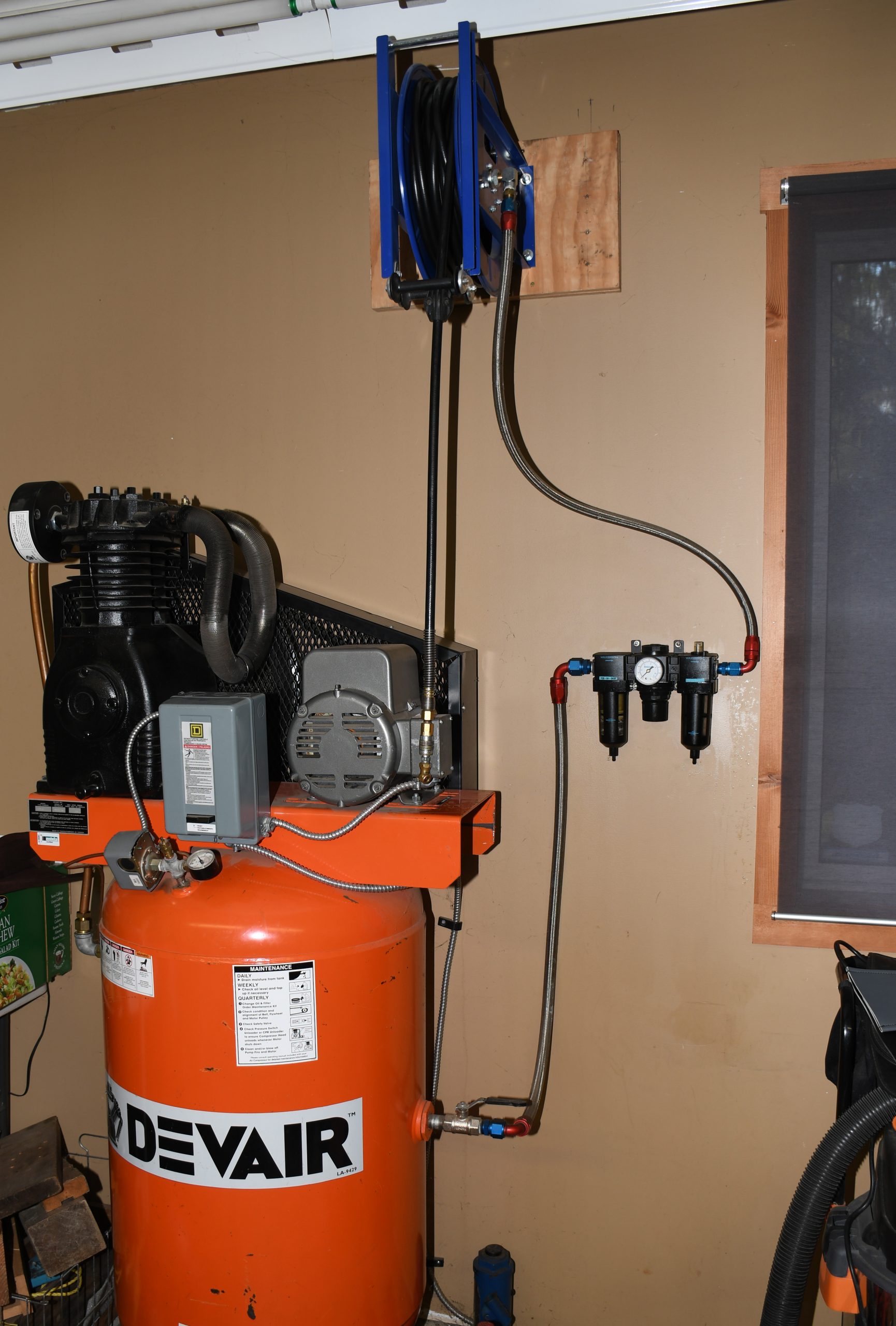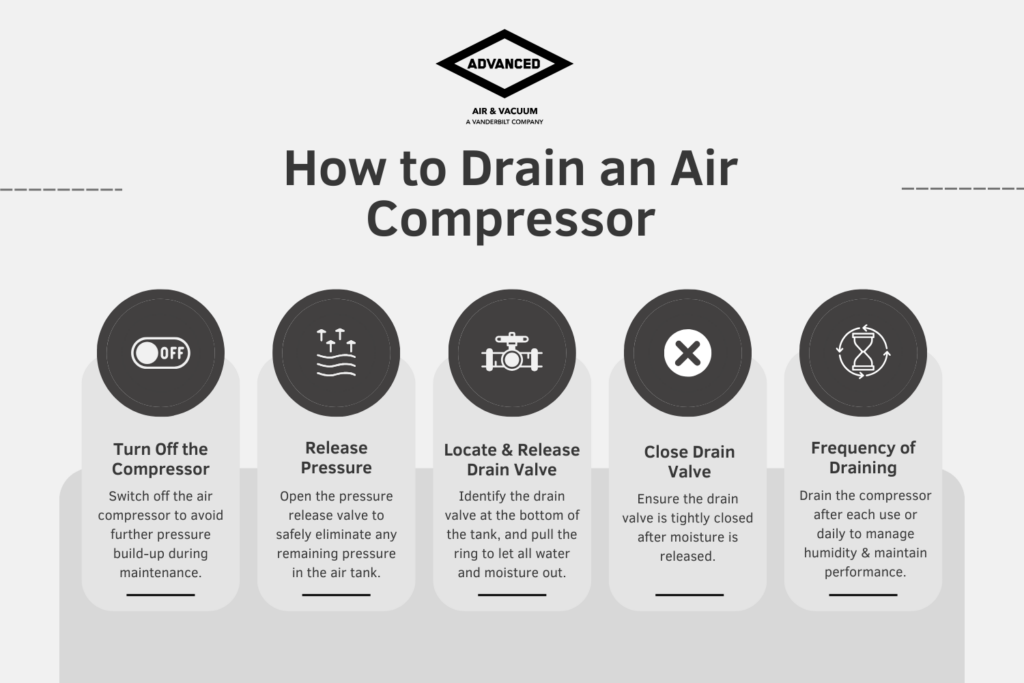To drain water from an air compressor, release the drain valve at the tank’s bottom. Regularly maintain your air compressor to ensure optimal performance.
Draining water from your air compressor is essential for preventing rust and maintaining efficiency. Air compressors naturally collect moisture, which can lead to corrosion and reduced functionality if not properly managed. Regular maintenance, including draining accumulated water, extends the compressor’s lifespan and ensures it operates effectively.
A well-maintained air compressor not only functions more reliably but also reduces the risk of costly repairs. Understanding and implementing basic maintenance tasks, such as water drainage, is crucial for anyone relying on this equipment. Proper upkeep ensures your air compressor remains a valuable tool for various tasks, from DIY projects to professional applications.
Importance Of Draining Water
An air compressor works by drawing in air, compressing it, and storing it in a tank. During this process, moisture in the air condenses and collects inside the tank. Draining water from your air compressor is vital for its longevity and performance. Neglecting this task can lead to severe issues.
Preventing Rust
Water inside the tank can cause rust. Rust weakens the tank’s structure. This can lead to dangerous leaks. Rust also contaminates the air supply.
Ensuring Efficiency
Water build-up affects the efficiency of the compressor. It takes more power to compress moist air. This increases energy consumption. Draining water helps maintain optimal performance.
Signs Of Water Accumulation
Water in your air compressor can cause many problems. It is important to know the signs of water accumulation. This will help keep your compressor working well.
Poor Performance
If your air compressor is not working well, it may have water inside. This water can lower the pressure of the air. Low pressure means your tools will not work right. Watch for weak air coming from the compressor. This is a sign of water inside.
Another sign is longer running times. If the compressor runs more than usual, it may have water. This water makes it hard for the compressor to reach the right pressure. The compressor works harder and longer.
Unusual Noises
Listen for strange noises from your air compressor. Water can make the compressor sound different. You may hear hissing or bubbling sounds. These sounds mean there is water inside.
Knocking noises can also be a sign. Water can cause parts to move in a bad way. This makes the compressor make loud, unusual noises. Always check for water if you hear these sounds.
| Sign | Description |
|---|---|
| Poor Performance | Weak air, longer running times |
| Unusual Noises | Hissing, bubbling, or knocking sounds |
Keep your air compressor in top shape. Watch for these signs of water accumulation.
Necessary Tools
Maintaining your air compressor is crucial for its longevity. One essential aspect is draining water from the unit. To do this efficiently, you’ll need a few necessary tools. Below, we discuss these tools in detail.
Drain Valve
The drain valve is a critical tool. It helps you release trapped moisture from the compressor tank. Usually located at the bottom of the tank, the drain valve is easy to access. Here’s how you can use it:
- Turn off the air compressor and unplug it.
- Locate the drain valve at the bottom of the tank.
- Place a container under the valve to catch the water.
- Slowly open the valve and let the water drain out.
Using the drain valve regularly prevents rust and extends the compressor’s life.
Air Compressor Manual
The air compressor manual is another essential tool. It provides specific instructions for maintaining your unit. Here are some key points to look for in the manual:
- Steps for draining water from the tank.
- Recommended maintenance schedule.
- Safety precautions during maintenance.
Always refer to the manual before starting any maintenance task. It ensures you follow the correct procedures and keep your compressor in optimal condition.
| Tool | Purpose |
|---|---|
| Drain Valve | Releases trapped moisture |
| Air Compressor Manual | Provides maintenance instructions |
Keeping these tools handy makes air compressor maintenance simpler and more effective.
Steps To Drain Water
Draining water from an air compressor is crucial for its maintenance. Water buildup can damage the compressor and reduce its efficiency. Follow these simple steps to ensure your air compressor runs smoothly.
Power Off
First, turn off the power to the air compressor. Unplug it from the electrical outlet. This step ensures your safety while you perform the maintenance.
Release Pressure
Next, release the pressure from the air tank. Locate the pressure relief valve on your compressor. Open the valve slowly to let the air escape. This step prevents any sudden bursts of air.
Open The Drain Valve
Find the drain valve at the bottom of the tank. Place a container under the valve to catch the water. Open the drain valve and allow the water to flow out.
Close The Drain Valve
After the water drains completely, close the drain valve tightly. Ensure there is no water left in the tank. This step prevents rust and extends the life of your compressor.
Power On
Finally, plug the air compressor back into the electrical outlet. Turn on the power and let the compressor build pressure again. Your air compressor is now ready for use.
Regular Maintenance Schedule
Keeping your air compressor in top shape requires a regular maintenance schedule. This ensures your machine runs efficiently and lasts longer. Regular checks and inspections can prevent costly repairs.
Daily Checks
Daily checks are essential for optimal performance. These tasks take just a few minutes but can save hours of downtime.
- Drain water from the air tank to prevent rust.
- Check oil levels in the pump (for oil-lubricated compressors).
- Inspect for leaks in hoses and fittings.
- Ensure the pressure gauge reads correctly.
Monthly Inspections
A more detailed inspection should be conducted monthly. These tasks help identify potential issues before they become serious problems.
| Task | Description |
|---|---|
| Check air filter | Clean or replace if dirty to ensure airflow. |
| Inspect belts | Look for wear and tear; replace if damaged. |
| Examine safety valve | Ensure it functions properly to prevent overpressure. |
| Tighten bolts | Check and tighten bolts and screws to prevent vibration issues. |
 Maintenance tips“/>
Maintenance tips“/>Common Mistakes
Maintaining your air compressor is crucial for its longevity and efficiency. One important task is draining water from the tank. Many people make common mistakes that can lead to serious problems. Below are some common mistakes to avoid.
Ignoring Water Levels
Ignoring water levels in your air compressor can cause damage. Water buildup leads to rust and reduces efficiency. Always check the water levels before and after use.
Use a dipstick or a sight glass to check the levels. If you notice water, drain it immediately. Waiting too long can lead to costly repairs.
| Consequence | Impact |
|---|---|
| Rust | Reduces tank life |
| Lower Efficiency | Increases energy use |
Not Using Proper Tools
Using the wrong tools can damage your air compressor. Always use tools recommended by the manufacturer. This ensures you don’t void your warranty.
Here are some tools you might need:
- Wrench
- Drain Valve
- Air Hose
Using the proper tools makes the job easier and safer. It also helps maintain the integrity of the compressor.
Make sure to store these tools in a safe place. Keeping them handy will make maintenance tasks quicker.
Safety Precautions
Draining water from an air compressor is crucial for maintenance. Safety is essential during this process. Follow these safety precautions to ensure a smooth and safe experience.
Wear Protective Gear
Always wear protective gear when working with air compressors. Protective gear includes:
- Safety goggles
- Gloves
- Hearing protection
Safety goggles protect your eyes from debris. Gloves keep your hands safe from hot surfaces. Hearing protection guards your ears from loud noises.
Follow Manufacturer Instructions
Read and follow the manufacturer instructions. Each air compressor is different. Instructions provide specific safety guidelines.
Look for details about:
- Proper draining methods
- Recommended tools
- Maintenance schedules
Keeping these instructions handy ensures safe operation and longevity of your air compressor.

Benefits Of Proper Maintenance
Proper maintenance of your air compressor offers many benefits. It ensures the machine runs smoothly and efficiently. Regular care can prevent costly breakdowns and extend the life of your equipment.
Extended Lifespan
Regular maintenance can significantly extend the lifespan of your air compressor. This is because proper care prevents wear and tear. By draining water from the air compressor, you avoid rust and corrosion. Clean parts function better and longer.
A well-maintained compressor can last years longer. This means fewer replacements and reduced downtime. Your investment in regular maintenance pays off with a longer-lasting machine.
Cost Savings
Maintaining your air compressor can save you money. Regular checks can catch small issues before they become big problems. This avoids expensive repairs. Draining water from the air compressor prevents damage to critical parts.
Proper upkeep reduces the need for new parts. It also ensures your machine runs efficiently. An efficient machine uses less energy. This leads to lower electricity bills. Investing in maintenance saves money in the long run.
Consider the cost savings in a simple table:
| Maintenance Task | Cost Savings |
|---|---|
| Regular Checks | Prevents costly repairs |
| Draining Water | Avoids part replacements |
| Cleaning Parts | Increases efficiency |

Frequently Asked Questions
How Often Should I Drain My Air Compressor?
You should drain your air compressor after every use. Regular draining prevents moisture buildup, which can cause rust and damage.
What Happens If I Don’t Drain The Air Compressor?
If you don’t drain your air compressor, moisture can accumulate. This can lead to rust, decreased efficiency, and potential damage.
Can I Automate The Draining Process?
Yes, you can use an automatic drain valve. This device will periodically release accumulated moisture, making maintenance easier.
Is Draining The Air Compressor Necessary In Cold Weather?
Yes, draining is essential even in cold weather. Moisture can freeze and cause blockages or damage to the system.
Conclusion
Regularly draining water from your air compressor is essential for optimal performance. Consistent maintenance extends its lifespan and enhances efficiency. Following these simple steps ensures your compressor remains in top shape. Invest time in proper care to avoid costly repairs and downtime.
Keep your air compressor running smoothly with these maintenance tips.

